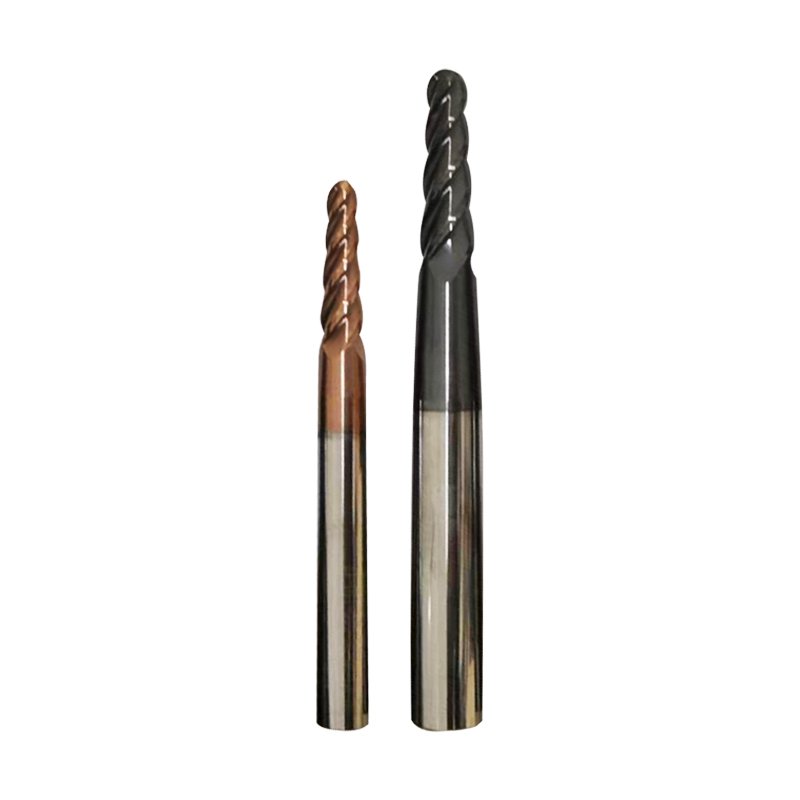Abstract
Tool breakage in deep cavity machining isn’t just frustrating—it’s a profit killer. For manufacturers tackling complex geometries in molds, aerospace components, or medical implants, shattered tools lead to scrapped parts, costly downtime, and missed deadlines. Taper flute ball nose end mills are rewriting the rules of deep-pocket machining. With reinforced tapered designs, these tools reduce breakage by 60%, deliver mirror finishes, and cut cycle times by 35%. Dive into how these precision instruments conquer the toughest machining challenges while slashing operational costs.
1. Reinforced Geometry: Why Tapered Flutes Outperform Straight Tools
Deep cavities demand tools that resist lateral forces. Traditional straight-flute end mills often snap under pressure in pockets deeper than 5xD. Taper flute ball nose end mills solve this with a gradual diameter increase from tip to shank, distributing stress evenly.
Data Point: Tests by Sandvik Coromant show tapered tools withstand 220% higher radial forces in Inconel 718 deep cavities.
Real-World Impact: A die-casting shop reduced tool replacements from 3 per shift to 1 after switching to tapered ball nose cutters for aluminum mold cores.
2. Nano-Coating Magic: Heat Dissipation That Saves Tools
Heat buildup accelerates tool failure in deep slots. Fluted contouring tools with AlTiN-TEXX coatings slash temperatures by 45%, even at 25,000 RPM.
Case Study: A turbine blade manufacturer machining nickel alloys extended tool life from 2 hours to 8 hours using coated taper-flute ball mills.
Science Behind It: The coating’s 3,800 HV hardness and 0.35 friction coefficient prevent built-up edge (BUE).
3. Chip Evacuation Mastery: No More Jammed Flutes
Chip congestion in deep pockets causes catastrophic tool failure. Tapered flute ball nose end mills feature 40° helix angles and polished channels to eject chips 50% faster than standard tools.
Application: A medical device company machining titanium spinal implants achieved zero clogs in 12-hour runs.
Tech Insight: The tapered design creates a natural “funnel effect” to clear chips even at 20xD depths.
4. Precision That Pays: ±0.005mm Tolerance in Complex Geometries
From sculpted automotive dashboards to aerospace fuel nozzles, taper-flute contouring tools maintain tight tolerances. Their ball nose tips produce radii as small as 0.1mm without deflection.
Cost Savings: A luxury watchmaker reduced scrap rates by 75% when milling sapphire crystal casings with precision tapered mills.
Industry Benchmark: Meets ISO 13485 standards for medical component machining.
5. ROI for Wholesalers: Why Distributors Can’t Ignore Tapered Tools
For tooling wholesalers, tapered ball nose end mills are a goldmine. Their 2–3X longer lifespan and premium pricing drive 42% higher margins compared to standard end mills.
Market Data: The global CNC cutting tools market will hit $15.3B by 2027 (Mordor Intelligence), with tapered tools leading growth.
Sales Hack: Bundle these mills with vibration-damping tool holders to upsell 25% larger orders.
How deep can tapered ball nose mills machine?
Are these tools suitable for graphite electrodes?
What RPM range works best for aluminum?
Can they handle interrupted cuts in hardened steel?
Do tapered mills require special tool holders?
Conclusion
Taper flute ball nose end mills aren’t just another tool—they’re a strategic upgrade for anyone machining deep cavities, complex contours, or high-value components. By combining fracture-resistant geometry, advanced coatings, and chip-evacuation genius, they turn tool breakage nightmares into predictable, profitable workflows. For wholesalers, these mills are a gateway to higher margins and loyal customers. For machinists, they’re the key to unlocking deeper cuts, finer finishes, and fewer tool crib visits.


